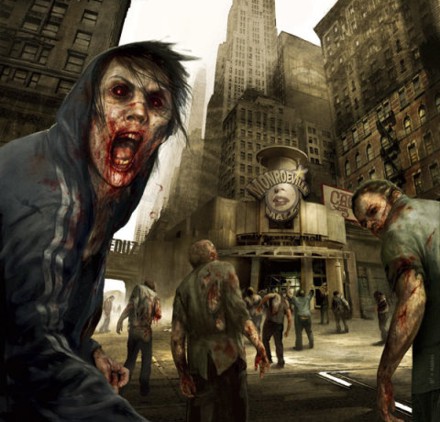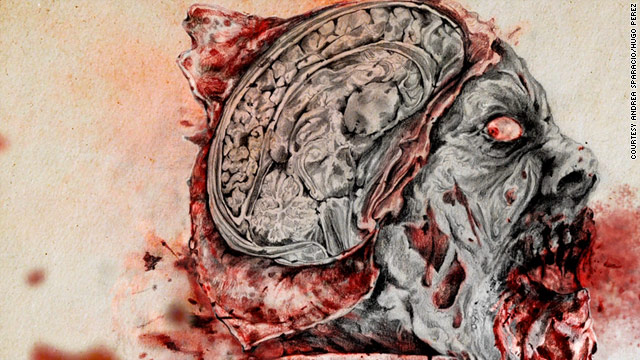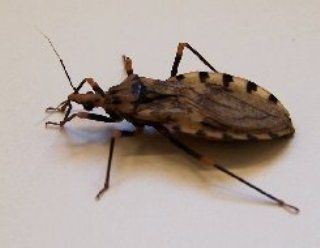Tag Archives: science
Colbert: Zombies Are Intellectual Elites – ‘All They Care About Is Braiiiiiiins’
 College student eating a housemate’s heart? Homeless man eating another homeless man’s face? Porn star sending body parts to government members? “Cannibalism is the hot new trend,” observed Stephen Colbert on last night’s Colbert Report. “And you thought saggy pants were annoying.” The recent spate of these freak incidents in the news has wide swathes of the American public convinced we have a zombie apocalypse on our hands. “It does make one wonder,” Colbert said. “After all, something has clearly eaten [Fox News host] Trace Gallagher’s brain.”
College student eating a housemate’s heart? Homeless man eating another homeless man’s face? Porn star sending body parts to government members? “Cannibalism is the hot new trend,” observed Stephen Colbert on last night’s Colbert Report. “And you thought saggy pants were annoying.” The recent spate of these freak incidents in the news has wide swathes of the American public convinced we have a zombie apocalypse on our hands. “It does make one wonder,” Colbert said. “After all, something has clearly eaten [Fox News host] Trace Gallagher’s brain.”
So it came as a relief when the federal Centers for Disease control on June 1 told the Huffington Post that “CDC does not know of a virus or condition that would reanimate the dead (or one that would present zombie-like symptoms).” Colbert was not buying it, though, especially in light of a (tongue-in-cheek”) CDC “zombie awareness” campaign last year. “It makes sense that zombies would be attracted to science,” he said. “I mean, they’re intellectual elites. All they care about is braaaaaiiiiiinnnnns.”
Experts say Chagas disease is ‘new HIV/AIDS of the Americas’
The New York Times reports experts from Baylor College of Medicine, Houston, Texas noted that nearly 8 million people have contracted the disease in the Americas and that most sufferers live in Bolivia, Mexico, Columbia and Central America. Fox News reports experts are worried that the disease that was once found mainly in Latin America is spreading to the U.S due to travel and immigration. About 30,000 people in the U.S. are believed to be infected with Chagas.
According to Daily Mail, the disease was named after a Brazilian doctor Carlos Ribeiro Justiniano Chagas, who discovered it in 1909. The disease is listed among the Neglected Parasitic Infections in the world. The list includes five other parasitic infections identified as top priority for public health action. Daily Mail reports experts say more than 10,000 people died of Chagas disease in 2008.
Chagas, like AIDS, has been linked to poverty and poor living conditions. The disease is found in the United States mostly among immigrants. Chagas disease is difficult to detect and symptoms may take several years to emerge after infection. If the infection is detected early, it can be successfully treated by an intensive course of drugs. But if detected late, the disease is difficult or impossible to cure. The New York Times reports that drugs for treating the disease are not as expensive as AIDS drugs but there are shortages in developing countries.The long period of incubation of the disease makes it difficult to detect it and the illness is often left untreated.
All blood banks in Latin America screen for traces of the disease. Daily Mail reports blood banks in the U.S. began screening in 2007.
Chagas infection is transmitted by the bite of reduviid blood suckling bugs called Triatomine bugs. The species are black wingless insects about 20 mm in length and are commonly known as “kissing bugs.”
When the bug bites its victim, it releases a single-celled parasite, called Trypanosoma cruzi into the blood stream. The parasite is closely related to the trypanosomes that cause African Sleeping Sickness. According to The New York Times, this explains why Chagas is sometimes called “American trypanosomiasis.”
The course of the disease goes through two phases, the acute and the severe stages.
The Huffington Post reports that even though there are significant similarities between Chagas and HIV/AIDS, there are also strong distinctions. HIV/AIDS is a sexually transmitted viral disease but Chagas disease is caused by a parasite called Trypanosoma cruzi. While HIV/AIDS attacks the body’s immune system, Chagas primarily targets the heart and digestive organs.
In the acute phase of illness, the disease simply incubates and may take years for symptoms to emerge. In the severe stage, symptoms such as constipation, abdominal pains, digestive disturbances and cardiac arrhythmia develop. The Huffington Post reports the National Institute of Health (NIH) says complications from Chagas disease can include inflammation of the heart, esophagus and colon, as well as irregular heartbeat and heart failure.
The parasite finally makes it way to the victim’s heart where it multiplies rapidly. Daily Mail reports that about a quarter of people who contract Chagas develop enlarged heart or intestines that may burst and cause sudden death.
According to The Huffington Post, the NIH reports that although it may “take more than 20 years from the original time of infection to develop heart or digestive problems,” the onset of symptoms can be dramatic.
Experts have long speculated that Charles Darwin contracted the illness during his five year trip on HMS Beagle when he was a young man in his 20s. Darwin died of heart failure 47 years after the voyage. He reported symptoms that experts think may be symptoms of Chagas, though others believe that some of the symptoms, such as heart palpitations, were psychogenic in origin.
Darwin, however, mentioned in his journal that he was bitten by a “wingless black bug” while traveling in South America during the voyage of HMS Beagle.
Inside zombie brains: Sci-fi teaches science

- A new novel “The Zombie Autopsies” is about, well, zombies
- The zombie virus basically eats the brain down to the amygdala
- When it’s humans vs. zombies, the best solution is a strategic attack, mathematician says
Zombie author and expert Dr. Steven Schlozman will join us for a Twitter chat at 12:00 p.m. ET on Tuesday, April 26. Tweet your questions to @cnnhealth and follow along at #cnnzombies.
(CNN) — An airborne virus is rapidly turning people into zombies. Two-thirds of humanity has been wiped out. Scientists desperately look for a cure, even as their own brains deteriorate and the disease robs them of what we consider life.
Relax, it’s only fiction — at least, for now. This apocalyptic scenario frames the new novel “The Zombie Autopsies” by Dr. Steven Schlozman, a child psychiatrist who holds positions at Harvard Medical School and the Massachusetts General Hospital/McLean Program in Child Psychiatry.
You might not expect someone with those credentials to take zombies seriously, but it turns out the undead are a great way to explore real-world health issues: why certain nasty diseases can destroy the brain, how global pandemics create chaos and fear, and what should be done about people infected with a highly contagious and incurable lethal illness.
“One of the things zombie novels do is they bring up all these existential concerns that happen in medicine all the time: How do you define what’s alive?” says Schlozman, who has been known to bounce between zombie fan conventions and academic meetings.
“When is it appropriate to say someone’s ‘as-good-as-dead,’ which is an awful, difficult decision?”
What a zombie virus would do to the brain
So maybe you’ve seen “Night of the Living Dead,” read “World War Z,” or can’t wait for the return of the AMC show “The Walking Dead,” but you probably don’t know what differentiates the brains of humans and zombies.
First things first: How does the zombie disease infect its victims? Many stories in the genre talk about biting, but Schlozman’s novel imagines a deliberately engineered virus whose particles can travel in the air and remain potent enough to jump from one person to another in a single sneeze.
Now, then, to the brain-eating. The zombie virus as Schlozman describes it basically gnaws the brain down to the amygdala, an almond-shaped structure responsible for the “fight or flight” response. The zombies always respond by fighting because another critical part of the brain, the ventromedial hypothalamus, which tells you when you’ve eaten enough, is broken.
The brain’s frontal lobes, responsible for problem-solving, are devoured by the virus, so zombies can’t make complex decisions. Impairment in the cerebellum means they can’t walk well, either. Also, these humanoids have an unexplained predilection for eating human flesh.
“The zombies in this book are stumbling, shambling, hungry as hell,” Schlozman said. “Basically they’re like drunk crocodiles; they’re not smart, they don’t know who you are or what you are.”
Why we love those rotting, hungry, putrid zombies
How a zombie virus would be made
So the bloodthirsty undead wander (or crawl) around spreading a lethal illness ominously called ataxic neurodegenerative satiety deficiency syndrome, or ANSD, for short.
“When something really terrifying comes along, especially in medicine or that has a medical feel to it, we always give it initials. That’s the way we distance ourselves from it,” Schlozman said.
The virus has several brain-destroying components, one of which is a “prion,” meaning a protein like the one that causes mad cow disease. In real life, prions twist when they are in an acidic environment and become dangerous, Schlozman said. How our own environment has changed to make prions infectious — getting from the soil to the cows in mad cow disease, for instance — is still a mystery.
Now here’s something to send chills up your spine: In Schlozman’s world, airborne prions can be infectious, meaning mad cow disease and similar nervous-system destroyers could theoretically spread just like the flu. Swiss and German researchers recently found that mice that had only one minute of exposure to aerosols containing prions died of mad cow disease, as reported in the journal PLoS Pathogens. A follow-up described in Journal of the American Medical Association showed the same for a related disease that’s only found in animals called scrapie. Of course, these are mice in artificially controlled conditions in a laboratory, and humans do not exhale prions, but it could have implications for safety practices nonetheless.
Like mad cow disease, the zombie disease Schlozman describes also progresses in acidic environments. In the book, a major corporation doles out implantable meters that infuse the body with chemicals to artificially lower acidity when it gets too high. But, sadly, when acidity is too low, that also induces symptoms that mimic the zombie virus, so it’s not a longterm solution. Everyone who gets exposed eventually succumbs, Schlozman said.
As for the unknown component of the zombie disease that would help slowly zombifying researchers in their quest for a cure, that’s up for the reader to figure out — and the clues are all in the book, Schlozman said.
How we’d fight back
You can’t ethically round up fellow survivors to kick some zombie butt unless the undead have technically died. And in Schlozman’s book, a group of religious leaders get together and decide that when people reach stage four of the disease, they are basically dead. That, of course, permits zombie “deanimation,” or killing.
The ‘zombie theology’ behind the walking dead
And how do you kill a zombie? Much of zombie fiction knocks out zombies through shots to the head. That, Schlozman said, is because the brain stem governs the most basic functioning: breathing and heartbeat.
A zombie-apocalypse disease like the one he describes probably wouldn’t evolve on its own in the real world, he said.
But, as we’ve seen, individual symptoms of zombies do correspond to real ailments. And if they all came together, the disease would be creepily efficient at claiming bodies, Schlozman said.
Bad news, folks: Even if people contracted a zombie virus through bites, the odds of our survival aren’t great.
A mathematician at the University of Ottawa named Robert Smith? (who uses the question mark to distinguish himself from other Robert Smiths, of course), has calculated that if one zombie were introduced to a city of 500,000 people, after about seven days, every human would either be dead or a zombie.
“We’re in big, big trouble if this ever happens,” Smith? said. “We can kill the zombies a bit, but we’re not very good at killing zombies fundamentally. What tends to happen is: The zombies just win, and the more they win, the more they keep winning” because the disease spreads so rapidly.
The best solution is a strategic attack, rather than an “every man for himself” defense scenario, he said. It would take knowledge and intelligence, neither of which zombies have, to prevail.
Why study zombies?
In his day job, Smith? models how real infectious diseases spread. But he’s already reaped benefits from his work on zombies. For instance, while many mathematical models only deal with one complicated aspect of a situation at a time, he tackled two — zombie infection and zombie-killing — when it came to speculating about outbreaks.
When it came time for modeling of real-world human papillomavirus (HPV), then, Smith? felt equipped to handle many facets of it at the same time, such as heterosexual and homosexual transmission of HPV.
“Knowing what we knew from zombies allowed us to actually take on these more complicated models without fear,” he said.
Studying zombies is also a great way to get young people excited about science. Smith?, who was on a zombie-science panel with Schlozman through the National Academy of Sciences’ Science and Entertainment Exchange in 2009, has also seen math-phobic people get interested in mathematics by reading about his work with zombies.
“There are insights that we gain from the movies, and from fiction, from fun popular culture stuff, that actually can really help us think about the way that science works, and also the way science is communicated,” he said.
And as to why people like reading about zombies and watching zombies so much, Schlozman points to the impersonal nature of things in our society, from waiting in line in the DMV to being placed on hold on a call with a health insurance company.
Think about all the situations in daily life where you sense a general lack of respect for humanity, and zombies make a little more sense.
“The zombies themselves represent a kind of commentary on modernity,” Schlozman says. “We’re increasingly disconnected. That might be the current appeal.”
Real Life Zombies
The thought of our bodies walking around and operating without our personal conscious or as the more spiritual believe without our soul is an idea that has intrigued and captivated the minds of human beings for centuries. Whether it be the living-dead and body snatchers of Hollywood movies or the stories of voodoo priests using potions to turn rivals into mindless drones to do their bidding, myths, movies, and stories about zombies have been a mainstay in human culture. But the idea of our bodies walking around without freewill or after we have passed may be closer to the realm of the natural than we all thought.
We have all been in the situation where we see a hideous bug in our sink or bathtub and instead of squishing it we take a more timid approach and turn the water on and drown the pest. Imagine you try to that and you watch the ugly sucker spin down the drain. You return to the bathroom later to make the horrifying discovery that the bug had returned from the dead. There are two possibilities: either you have a bathroom infested with bugs or you are dealing with a wolf spider, whose appearance is even more terrifying than its name.

Soviet Expiriment resurected dead, Real Zombies
In the 1940s, Soviet scientists were able to bring the dead back to life. This very technology will be the driving force behind the future Zombie apocalypse. 71 years later, we can finally get a peek through the Iron Curtain. What you see might horrify you. A poor dog, Torn apart in the name of science. Its lungs, hart and head, put to death then reanimated. Was this ever tested on humans, are Zombies real? Yes, as we can see, this has been done a very long time ago. Deep within Soviet Russia the communists scientist have played God. The day of Judgement will rain down on humanity and the dead shall rise. Nazi also conducted experiments with for nazi zombies. refer to times article for more details
